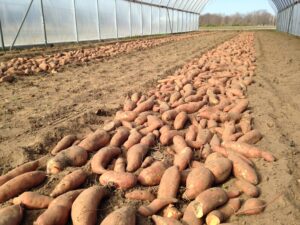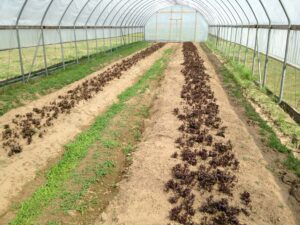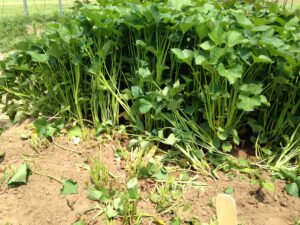2016 Annual Report for LNC15-369
Strengthening Organic Sweet Potato Propagation Systems in the North Central Region
Summary
We completed year one of a three year project. We established field plots and plots within high tunnels for the production of sweetpotato slips. We investigated the effects of high tunnels on slip morphological characteristics and found a greater number of marketable slips were produced in the high tunnels. However, slips from outside plot had greater compactness (dry weight/length). We also explored seed root planting density and its effects on slip production. Not surprisingly, increasing seed root density also increased slip number per area. However, the benefit appears to be reduced above 65 seed roots per square meter. Slips from high tunnels and open field were planted out to determine any influence on root yield. First year data suggests no significant different in yield per plant based on slip origin. In the lab we established a visual rating scale for slip quality to determine when a slip would be considered unmarketable. We also obtained preliminary data suggesting a shipping container lining can increase water content of slips during storage. However, there may be negative implications of increased humidity during shipping.
Objectives/Performance Targets
We are on target with our objectives. We have conducted first year research station trials to evaluate the efficiency of producing sweetpotato slips in high tunnels. We have also conducted first year experiments on postharvest physiology of slips in simulated storage and shipping conditions including a visual rating scale of harvested slips. We have secured two graduate students (Masters) who are incorporating this work into their degree programs. A grower survey was conducted at the Great Plains Growers Conference to establish baseline data.
Accomplishments/Milestones


 Sweetpotato slips can be successfully produced in high tunnels and then field planted to produce a marketable crop. We were able to establish baseline data from slips produced in high tunnels and those produced in open field. Data we collected included total marketable number and weight and cull weight. We also collected morphological data including fresh and dry weight, leaf area, stem diameter, length, and number of nodes. We also calculated slip ‘compactness’ (dry weight/length). Seed root planting density was investigated to determine how it influenced slip characteristics. Roots were planted at 45, 65, or 85 roots/square meter. We determined that increasing seed root density increase slip number per unit area, but there is likely a limit to the benefits of increasing density. Slips that were produced in high tunnel or open field produced a similar yield when field planted and grown out. In the lab we were able to establish a 9 point visual scale for rating sweetpotato slips. This simple, but effective, tool for communicating slip condition previously did not exist. We also established some baseline preliminary data for postharvest physiology of slips. We measured water loss and CO2 production from slips in storage over time and different temperatures. We also measured electrolyte leakage from leaf discs. Leaf color and chlorophyll content were documented as well. Preliminary data showed water loss from slips was greatly reduced when stored in wax-lined boxes. However, CO2 production was increased and slip quality rapidly declined in the wax-lined boxes. Electrolyte leakage was also hastened in the wax-lined boxes.
Sweetpotato slips can be successfully produced in high tunnels and then field planted to produce a marketable crop. We were able to establish baseline data from slips produced in high tunnels and those produced in open field. Data we collected included total marketable number and weight and cull weight. We also collected morphological data including fresh and dry weight, leaf area, stem diameter, length, and number of nodes. We also calculated slip ‘compactness’ (dry weight/length). Seed root planting density was investigated to determine how it influenced slip characteristics. Roots were planted at 45, 65, or 85 roots/square meter. We determined that increasing seed root density increase slip number per unit area, but there is likely a limit to the benefits of increasing density. Slips that were produced in high tunnel or open field produced a similar yield when field planted and grown out. In the lab we were able to establish a 9 point visual scale for rating sweetpotato slips. This simple, but effective, tool for communicating slip condition previously did not exist. We also established some baseline preliminary data for postharvest physiology of slips. We measured water loss and CO2 production from slips in storage over time and different temperatures. We also measured electrolyte leakage from leaf discs. Leaf color and chlorophyll content were documented as well. Preliminary data showed water loss from slips was greatly reduced when stored in wax-lined boxes. However, CO2 production was increased and slip quality rapidly declined in the wax-lined boxes. Electrolyte leakage was also hastened in the wax-lined boxes.
Impacts and Contributions/Outcomes
We made significant progress in 2016 and used several opportunities to make various interest groups aware of our work. Based on first year’s data we began developing budgets and comparison models and methods for an economic feasibility study with collaboration from the Department of Agricultural Economics. Data was presented at the Great Plains Growers Conference, the Seward County Community College Specialty Crop Production Workshop, and at a K-State Department of Horticulture and Natural Resources Seminar Series. Presentations and field plot tours at the Olathe Horticulture Research and Extension Center were conducted during a public open house in July (2016) and to commercial growers and apprentices of the Growing Growers program in August (2016). The K-State Research & Extension Community Development Program Focus Team toured the research plots in August (2016) as well.
Collaborators:
Assistant Professor
Kansas State University
331 D Waters Hall
Manhattan, KS 66506
Office Phone: 7855323033
Assistant Professor
Kansas State University
K-State Olathe
22201 Innovation Dr
Olathe, KS 66061
Office Phone: 9133077370
Assistant Professor
Kansas State University
35230 West 135th
Olathe, KS 66061
Office Phone: 9138562335